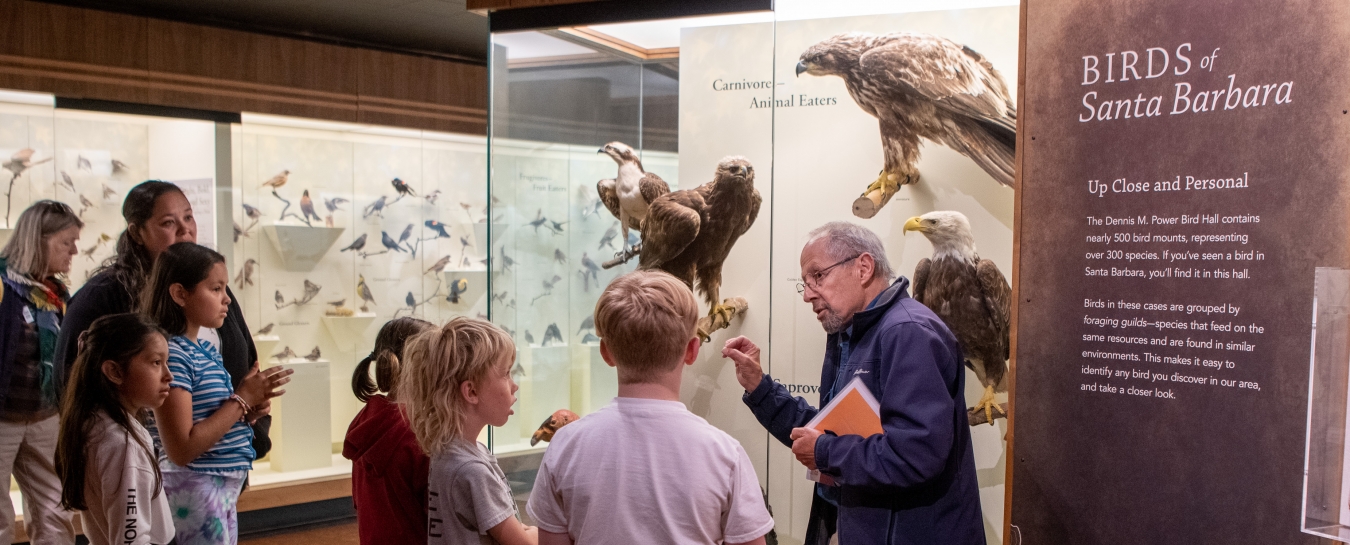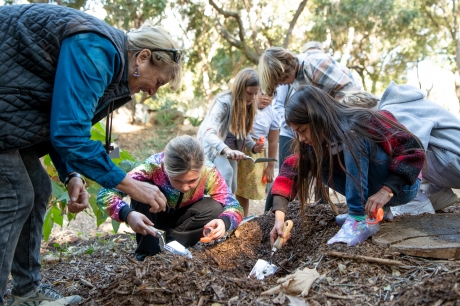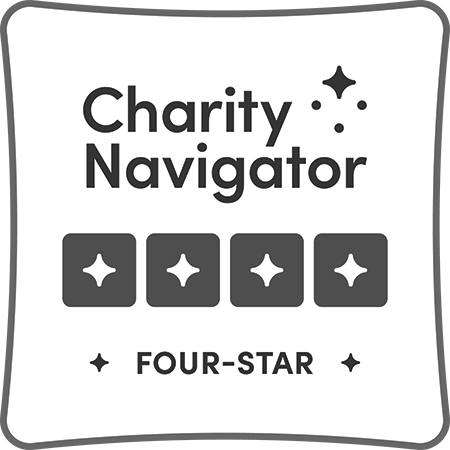
Field Trips at the Museum
- Registration for Fall 2025 opens Wednesday, August 27, 2025
(Sep. 22–Dec.19, 2025) - Registration for Winter/Spring 2026 opens Wednesday, November 5, 2025
(January 7–March 27, 2026) - Registration for Spring 2026 opens Wednesday, January 14, 2026
(April 6–May 22, 2026)
We are delighted to offer a variety of NGSS-aligned guided school field trip programs for the 2025-26 school year, designed for grades K–12.
If you are interested in a self-guided visit, please submit a request for a reservation at least three business days in advance using our online Group Visit Request form for self-guided groups at the Museum. or e-mail bookings@sbnature2.org or call 805-682-4711 ext. 162.
About K–4th Grade Choices
Field trips aligned with K–4th grade Next Generation Science Standards take place at the Museum on Wednesdays, Thursdays, and Fridays from 10:00 AM to noon. These field trips include a break in our Prehistoric Forest, where students can stretch their legs and meet some dinosaurs. Teachers assemble a two-part experience from the following program options:
- Part one: Choose an NGSS-aligned Lab/Class OR an NGSS-aligned Astronomy School Program
- Part two: Choose a Magical Museum Tour OR a Backyard Adventure
About 5th Grade Choices
Teachers of 5th graders will find that two kinds of field trips align with their Next Generation Science Standards. They can choose between a two-part field trip on Wednesdays, Thursdays, and Fridays, or opt for one of the two-hour longform programs offered to 5th grade and up on Mondays.
About 6–12th Grade Choices
Field trips aligned with 6th–12th grade Next Generation Science Standards take place at the Museum on Mondays from 10:00 AM to noon. Teachers choose between an Environmental Conservation Program or an Astrono-Monday Program.
Frequently Asked Questions
Have a question about capacity, booking, payment, logistics, or self-guided visit? Scan our Museum Field Trip FAQ.
Menu of Programs
The field trips below are grouped by their alignment with grade-specific Next Generation Science Standards. They can all be adjusted to work for a range of grade levels. If you’re interested in a program listed for another grade, please contact bookings@sbnature2.org for details or to have a program adjusted for your class.
Jump to programs by grade-specific standards:
Kindergarten Standards
1st Grade Standards
2nd Grade Standards
3rd Grade Standards
4th Grade Standards
5th Grade Standards
5th–12th Grade Standards
Kindergarten Standards
Astronomy School Program - Sky Partners
NGSS: 1-ESS1-1, 1-ESS1-2
What do the Earth, Moon, and Sun have to do with each other? Students will explore this dynamic relationship and more in a full-dome planetarium show followed by a kinesthetic astronomy activity and solar viewing at our Palmer Observatory (weather permitting). Students will use observations of the Sun, Moon, and stars to describe the patterns we see in the sky.
Lab - Meet the Teeth
NGSS: K-2-ETS1-2, K-LS1-1
What do teeth tell us about what an animal can eat? What can animals’ bodies tell us about how they live? In this interactive program, students get up close and personal with some familiar wild animals (safely stuffed), and hands-on with animal skulls. Students learn to distinguish between herbivores, omnivores and carnivores.
Magical Museum Tour - Who Lives Where?
NGSS: K-ESS3-1
Students interact with their peers and our Museum educators as they explore our galleries to help solve the mystery of where animals make their homes in the ocean, in the forest, underground, and high up in the trees.
Backyard Adventure
Have students explore nature in our Museum Backyard! Students will embark on an adventure through different NGSS-aligned nature activities: hunting for critters in our Dig Pile, exploring our riparian ecosystem in our creek, getting up close with the Eyes in the Sky raptors, and more! This student-driven hands-on experience encourages curiosity and fosters a deeper understanding of our environment, making learning fun and engaging in the great outdoors!
1st Grade Standards
Astronomy School Program - Sky Partners
NGSS: 1-ESS1-1, 1-ESS1-2
What do the Earth, Moon, and Sun have to do with each other? Students will explore this dynamic relationship and more in a full-dome planetarium show followed by a kinesthetic astronomy activity and solar viewing at our Palmer Observatory (weather permitting). Students will use observations of the Sun, Moon, and stars to describe the patterns we see in the sky.
Lab - Meet the Teeth
NGSS: K-2-ETS1-2, K-LS1-1
What do teeth tell us about what an animal can eat? What can animals’ bodies tell us about how they live? In this interactive program, students get up close and personal with some familiar wild animals (safely stuffed), and hands-on with animal skulls. Students learn to distinguish between herbivores, omnivores and carnivores.
Magical Museum Tour - How Do They Do That?
NGSS: 1-LS1-1
Students work with their teachers, peers and their Museum educator guide to discover the variety of traits animals use to succeed where they live. They find out how these traits help animals be winners in a rough-and-tumble wild world, and what humans can learn from these amazing adaptations.
Backyard Adventure
Have students explore nature in our Museum Backyard! Students will embark on an adventure through different NGSS-aligned nature activities: hunting for critters in our Dig Pile, exploring our riparian ecosystem in our creek, getting up close with the Eyes in the Sky raptors, and more! This student-driven hands-on experience encourages curiosity and fosters a deeper understanding of our environment, making learning fun and engaging in the great outdoors!
2nd Grade Standards
Astronomy School Program - The Sky’s Seasonal Secrets
NGSS: 2-ESS1-1
Why do we have seasons? Why does the Sun set so early in the winter? Students will delve into these questions and more in a full-dome planetarium show followed by a kinesthetic astronomy activity and solar viewing at our Palmer Observatory (weather permitting). Students will learn about Earth’s orbit around the Sun, Earth’s rotation, and how Earth’s tilt creates seasons.
Lab - GeOdyssey
NGSS: 2-ESS1-1, 2-ESS2-2
Take a trip back in time to the birth of our Earth and investigate the forces that shape it today. Students will participate in hands-on activities and demonstrations to answer questions about our unique geologic journey here on the Central Coast, such as: what causes earthquakes, how did we get Mission Creek, and how are humans making our mark on this precious part of the world?
Magical Museum Tour - The Many, The Different, The Mighty: Biodiversity & Balance
NGSS: 2-LS4-1
In each ecosystem, there are unique and sometimes surprising connections that plants and animals share that form a vibrant, living web. Students explore Museum galleries to find the mighty teams of plants and animals that live together, intertwined for the good of all.
Backyard Adventure
Have students explore nature in our Museum Backyard! Students will embark on an adventure through different NGSS-aligned nature activities: hunting for critters in our Dig Pile, exploring our riparian ecosystem in our creek, getting up close with the Eyes in the Sky raptors, and more! This student-driven hands-on experience encourages curiosity and fosters a deeper understanding of our environment, making learning fun and engaging in the great outdoors!
3rd Grade Standards
Astronomy School Program - Sky Tellers
NGSS: 5-ESS1-2, History-Social Science Standards: 3.2.1
Students will explore the mysteries of our universe with a full-dome planetarium show. Students will receive an overview of the night sky and learn about Indigenous American legends that explain the reasons for day and night and why we have seasons. Weather permitting, we will also visit our Palmer Observatory for solar observing.
Class – Connecting with the Chumash: Archaeology & Anthropology
History-Social Science Standards 3.1.2, 3.2.1, 3.2.2
How do we know what we know about the past? What sort of work do archaeologists and anthropologists do? Why do we learn about human cultures in museums of natural history? Students will get hands-on experience examining replica Chumash artifacts as archaeologists and anthropologists in the field might do and learn about the role museums play in uplifting Indigenous voices in telling these stories.
Magical Museum Tour - Survivors: Awesome Animal Adaptations
NGSS: 3-LS4-2
Plants and animals have superpowers! When faced with environmental challenges, living things begin to make the most of the small changes in their bodies and behaviors that occur over many generations. Over time, these small changes can result in incredibly “smart” ways to be strong, healthy and successful in a wide variety of environments. On this tour, students explore our galleries to discover the ways that unique animal traits help them survive and thrive in the habitats they call home.
Backyard Adventure
Have students explore nature in our Museum Backyard! Students will embark on an adventure through different NGSS-aligned nature activities: hunting for critters in our Dig Pile, exploring our riparian ecosystem in our creek, getting up close with the Eyes in the Sky raptors, and more! This student-driven hands-on experience encourages curiosity and fosters a deeper understanding of our environment, making learning fun and engaging in the great outdoors!
4th Grade Standards
Astronomy School Program - Sky Tellers
NGSS: 5-ESS1-2, History-Social Science Standards: 4.2.1
Students will explore the mysteries of our universe with a full-dome planetarium show. Students will receive an overview of the night sky and learn about Indigenous American legends that explain the reasons for day and night and why we have seasons. Weather permitting, we will also visit our Palmer Observatory for solar observing.
Lab - Fossil Forensics
NGSS: 4-ESS1-1
How do we know so much about dinosaurs, and what does it take for paleontologists to bring our favorite dinosaurs to life? Students get their hands dirty as they examine the scene of a mystery preserved in ancient sand and stone. As junior paleontologists, students learn about how fossils are formed, discuss the evolutionary stories that fossils can tell, and participate in a hands-on mini dig of their very own, getting to understand the work of a paleontologist out in the field and inside a lab.
Magical Museum Tour - Beautiful Inside and Out
NGSS: 4-LS1-1
On this tour, students will search the Museum for evidence of the “hidden” aspects of plants and animals that help them live well in their habitats. Students work together to find and identify animal traits—some on the outside, some inside—that help them survive, eat well, and reproduce in their natural environments.
Backyard Adventure
Have students explore nature in our Museum Backyard! Students will embark on an adventure through different NGSS-aligned nature activities: hunting for critters in our Dig Pile, exploring our riparian ecosystem in our creek, getting up close with the Eyes in the Sky raptors, and more! This student-driven hands-on experience encourages curiosity and fosters a deeper understanding of our environment, making learning fun and engaging in the great outdoors!
5th Grade Standards
Astronomy School Program - Sky Tellers
NGSS: 5-ESS1-2, History-Social Science Standards: 3.2.1, 4.2.1
Students will explore the mysteries of our universe with a full-dome planetarium show. Students will receive an overview of the night sky and learn about Indigenous American legends that explain the reasons for day and night and why we have seasons. Weather permitting, we will also visit our Palmer Observatory for solar observing.
Magical Museum Tour - Keeping It All in Balance: Food Webs
NGSS: 5-PS3-1
All living things are connected, and precious but fragile living communities are essential to the health of everything that lives within them—and across the planet. Students will explore the different animal groups and ecosystems in our Museum to find how energy connects the lives of plants and animals in various habitats, and they will learn how breaking these connections by losing a single member of an ecosystem can threaten the whole community.
Backyard Adventure
Have students explore nature in our Museum Backyard! Students will embark on an adventure through different NGSS-aligned nature activities: hunting for critters in our Dig Pile, exploring our riparian ecosystem in our creek, getting up close with the Eyes in the Sky raptors, and more! This student-driven hands-on experience encourages curiosity and fosters a deeper understanding of our environment, making learning fun and engaging in the great outdoors!
Keep reading for more fifth grade options.
5th–12th Grade Standards
The two-hour longform programs below are offered on many Mondays throughout the school year.
Environmental Conservation Program - Be the Change: Community Science and Climate Advocacy
NGSS: 5-ESS3-1, MS-ESS3-3, HS-LS2-7, HS-ESS3-5, HSS: 5.1.1, VAPA: 5,6,8,Prof.VA:Pr6
Students will learn about climate change by closely observing the museum’s interactive exhibits. Students will also have the chance to get hands-on experience in different methods of community science to monitor our local environment at the museum. We hope this will spark students’ curiosity and give them the tools they need to continue monitoring and caring for nature in their own backyards. But, knowing is half the battle – we also will learn how to use this knowledge for advocacy of environmental justice in our communities.
Astrono-Monday - From Dust to Planets
NGSS: 5-ESS1-1, MS ESS1-2, MS ESS1-3, HS ESS1-6
Take a wild ride into the formation of our solar system in a full-dome planetarium show, with a question and answer with our Astronomy Presenter. Students will learn about the forces that hold our solar system together, why we have terrestrial planets and gas giants, and more. Weather permitting, we will also visit our Palmer Observatory for solar viewing. This two-hour program also includes fun interactives and dynamic demonstrations.
Have questions about the menu? Check out our Museum Field Trip FAQ or contact bookings@sbnature2.org.


